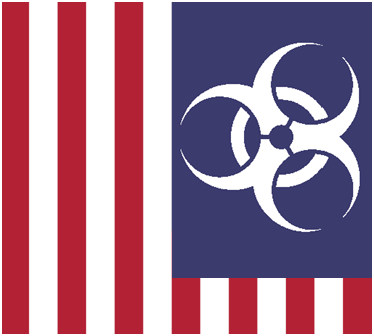
Desperate Democrats are reaching new levels of despicability, as they are busily making false claims regarding the Ebola threat and budget cuts to the National Institute of Health (NIH).
The Washington Times reports that the Center for Disease Control’s National Center for Emerging and Zoonotic Infectious Diseases, which has responsibility for Ebola amongst other diseases, has, contrary to politically motivated claims, seen its funding grow more than $100 million from 2010 to 2014. This 35 percent growth in the budget is about half accounted for by increased Obamacare spending, but the remaining increases are a result of a decision by the Congress to boost spending in this area, at a time when other areas of government were being kept at a zero growth rate.
However, it may be a good thing that politicians like Democrat Congressional Campaign Committee head Steve Israel are flinging about these specious charges, as it brings into focus federal government spending priorities that, at least for the short-term, should be altered to put more money into the current Ebola crisis.
Louisiana Governor Bobby Jindal, a public health expert, writes in Politico that, “Over the past five years, the CDC has received just under $3 billion in transfers from the [Prevention and Public Health] fund. Yet only 6 percent—$180 million—of that $3 billion went toward building epidemiology and laboratory capacity.”
Instead of building the infrastructure and increasing the number of scientists working on defeating the world’s deadliest diseases, Jindal explains that the Obama Administration prioritized the spending to provide almost three times as much money over that same five year period for something called the community transformation grant program.
What is this highly important community transformational grant program?
Jindal explains, “The program funds neighborhood interventions like “increasing access to healthy foods by supporting local farmers and developing neighborhood grocery stores,” or “promoting improvements in sidewalks and street lighting to make it safe and easy for people to walk and ride bikes.”
While societal transformation has been at the core of the Obama Administration’s six year quest, it is impossible not to imagine how many lives might have been saved in Africa and potentially around the world, if that extra $100 million a year had been poured into infectious disease research – one of the CDC’s core missions.
We cannot undo mistaken priorities of the past five years, but we can and must change them moving ahead.
Clearly, accelerating the production of very promising Ebola treatment options should be job one, and monies designated for bike paths should be immediately shifted to meet this imminent threat. And answers may well be at their fingertips.
There is an experimental Ebola virus treatment that has already been credited with helping cure the two American missionary health professionals who were transported to the CDC in Atlanta from Africa in September known as ZMapp.
NBC News reports that the development of ZMapp occurred through a partnership between the U.S. Army Medical Research Institute of Infectious Diseases (USAMRIID), private scientists and Reynolds American, Incorporated, the tobacco company.
The ZMapp drug is produced through the purposeful infection of tobacco plants with Ebola proteins. Within about a week, the tobacco plants begin producing the medicine that is credited with helping the two Ebola infected missionaries, and just might prevent a worldwide pandemic.
According to NBC News,prior to the use of the drug on the two infected American health care professionals, it had only been used on primates, but with stunning success. Primates who had been exposed for one day had a 100% survival rate, while those who have been exposed for two days had a 50 percent rate.
The irony is that the very tobacco plant that the public health world has seen as a scourge provides the ideal biological machine for producing this medicine, and the government needs to rapidly shift its course, and accelerate its commitment to developing this and other alternatives now.
Currently, Kentucky BioProcessing, a subsidiary of Reynolds American, has a small $10 million, three year grant from the U.S. Army to develop these Ebola fighting drugs. In today’s worldwide crisis environment, that commitment needs to be increased dramatically
Rather than continue on the federal government’s Food and Drug Administration’s current course of using nearly $600 million of tobacco industry money to fund anti-smoking campaigns, it would be wise, at least for the short-haul, for that money to be redirected to the U.S. Army to expedite testing and approvals for ZMapp.
While most people would support warning kids about the long term dangers of smoking, the money that is currently being questionably diverted to this public relations purpose is statutorily intended by the Tobacco Control act to scientifically study the impact of tobacco use of various tobacco products use on the general public. Wouldn’t it be more appropriate to use some of this money to explore how tobacco could actually save Ebola kids’ precious lives by ramping up FDA user fee moneys on this joint project with the U.S. army?
The long term health impacts of tobacco smoking are well known, and another advertising blitz isn’t going to raise this awareness. Instead, it makes sense to use this money dedicated to tobacco research to win the battle against the short term death sentence to kids laid down by the Grim reaper Ebola virus.
It would be refreshing if our federal government and its warring political parties were able to come together around this kind of positive, intelligent response to a crisis. A crisis which the World Health Organization is now predicting could reach 10,000 new cases per week in West Africa within the next month with a 70 percent mortality rate. For those bad at math, that is a death sentence for 7,000 Africans a week from Ebola next month with the body count accelerating.
A rational government would redirect the $100 million a year being spent by the CDC on promoting bike paths into the fight against Ebola and other infectious diseases. If local communities and states want bike paths, they can allocate funds for them, but the federal government has bigger fish to fry than painting bike lanes.
A rational government would immediately redirect the money projected to be spent on ads aimed at the transgender population and young adults telling them that smoking is unhealthy and might even cause wrinkle lines, into the U.S. Army’s contract for the development and production of ZMapp. This simple change in short-term priorities would allow a dramatic acceleration of the development, refinement and shipment of this life saving drug into Africa, while providing a supply to every hospital in the U.S. and elsewhere around the world.
But we don’t live with a rational government, it is a government dictated by who shouts the loudest. In this crisis, it is up to the people to demand that our lawmakers don’t put the profits of well-heeled anti-tobacco ad agencies, ahead of the lives of potentially hundreds of thousands if not millions of Africans and potentially millions of others worldwide.
The Obama Administration should make these common sense spending priority changes immediately to begin the process of saving tens of thousands of lives right now. But if they don’t, Congress should force these priority changes upon the Administration when they pass a Continuing Resolution in the lame duck session in December.
There really is no excuse for failing to act by redirecting these monies to save lives. This simple re-prioritizing of health care spending will save lives without busting the budget. But it will only happen if the people demand it.
The author is the vice president of public policy and communications for Americans for Limited Government.







